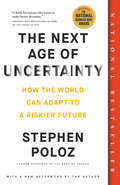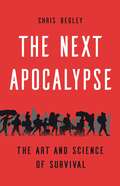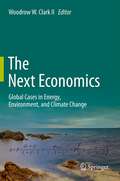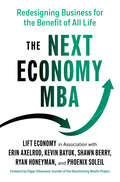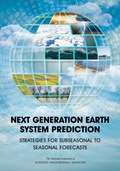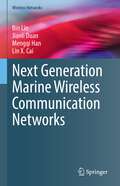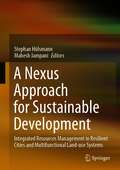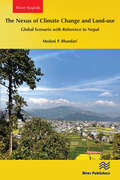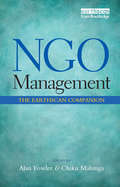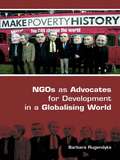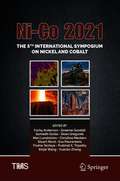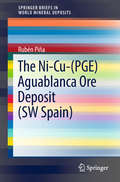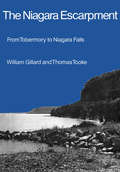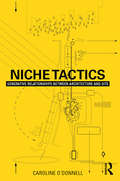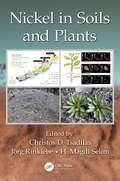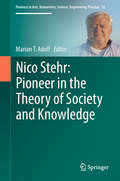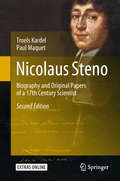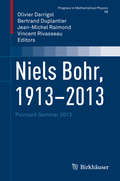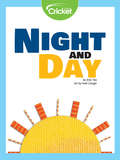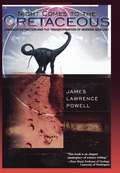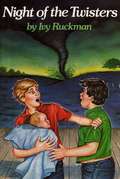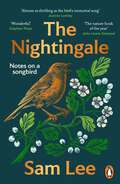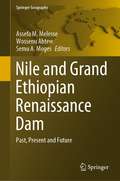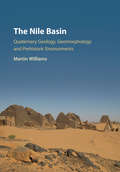- Table View
- List View
The Next Age of Uncertainty: How the World Can Adapt to a Riskier Future
by Stephen Poloz*WINNER OF THE 2023 NATIONAL BUSINESS BOOK AWARD**FINALIST FOR THE 2023 OTTAWA BOOK AWARD**SHORTLISTED FOR THE SHAUGHNESSY COHEN PRIZE FOR POLITICAL WRITING**SHORTLISTED FOR THE 2022 DONNER PRIZE*NATIONAL BESTSELLERFrom the former Governor of the Bank of Canada, a far-seeing guide to the powerful economic forces that will shape the decades ahead.The economic ground is shifting beneath our feet. The world is becoming more volatile, and people are understandably worried about their financial futures. In this urgent and accessible guide to the crises and opportunities that lie ahead, economist and former Governor of the Bank of Canada Stephen Poloz maps out the powerful tectonic forces that are shaping our future, and the ideas that will allow us to master them.These forces include an aging workforce, mounting debt, and rising income inequality. Technological advances, too, are adding to the pressure, putting people out of work, and climate change is forcing a transition to a lower-carbon economy. It is no surprise that people are feeling uncertain.The implications of these tectonic tensions will cascade throughout every dimension of our lives—the job market, the housing market, the investment climate, as well as government and central bank policy, and the role of the corporation within society. The pandemic has added momentum to many of them. Poloz skillfully argues that past crises, from the Victorian Depression in the late 1800s to the more recent downturn in 2008, give a hint of what is in store for us in the decades ahead. Unlike the purely destructive power of earthquakes, the upheaval that is sure to come in the decades ahead will offer unexpected opportunities for renewal and growth.Filled with takeaways for employers, investors, and policymakers, as well as families discussing jobs and mortgage renewals around the kitchen table, The Next Age of Uncertainty is an indispensable guide for those navigating the fault lines of the risky world ahead.
The Next Apocalypse: The Art and Science of Survival
by Chris BegleyIn this insightful book, an underwater archaeologist and survival coach shows how understanding the collapse of civilizations can help us prepare for a troubled future.Pandemic, climate change, or war: our era is ripe with the odor of doomsday. In movies, books, and more, our imaginations run wild with visions of dreadful, abandoned cities and returning to the land in a desperate attempt at survival.In The Next Apocalypse, archaeologist Chris Begley argues that we completely misunderstand how disaster works. Examining past collapses of civilizations, such as the Maya and Rome, he argues that these breakdowns are actually less about cataclysmic destruction than they are about long processes of change. In short: it&’s what happens after the initial uproar that matters. Some people abandon their homes and neighbors; others band together to start anew. As we anticipate our own fate, Begley tells us that it was communities, not lone heroes, who survived past apocalypses—and who will survive the next.Fusing archaeology, survivalism, and social criticism, The Next Apocalypse is an essential read for anxious times.
The Next Economics
by Woodrow W. Clark IIThe Next Economics focuses on how the field of economics must change and incorporate environment, energy, health and new technologies that are called externalities for stopping and reversing climate change. The field of economics needs to become a science. Economics in this book for the Green Industrial Revolution which goes beyond the third industrial revolution since it covers cases, examples and specific economic analyses that both scientific and global. The book concerns climate change and how the Economics for Externalities, needs to range from energy and national security to infrastructure and communities. Solutions and cases of the "Next Economics" are based in western philosophical economic paradigms and how that is changing due to the significance of current global economic and societal concerns. Finally practical applications for economics are explored using global environmental and energy issues. Areas that need a fresh look at and be integrated with economics, include the environment, social and political issues, energy, health climate change and their infrastructures, as they are major components of the macroeconomics for the future. Based on past economic models, these subjects have been lost or ill fitted into modern economic theory. The challenge is to explore and to look deeply into economics in order to provide it a new direction with the possibility for understanding, changing and saving the planet from climate change. This book presents to economists and policy-makers alike areas of environmental economics, energy policy, health and social issues which are needed to stop and reverse climate change.
The Next Economy MBA: Redesigning Business for the Benefit of All Life
by LIFT Economy Erin Axelrod Kevin Bayuk Shawn Berry Ryan Honeyman Phoenix SoleilThis radical and rigorous rethinking of the traditional MBA program combines solid business principles with a commitment to environmental and social justice.Many current and aspiring entrepreneurs are looking for a solid business education that also deeply aligns with their progressive values. Based on a course field-tested with over 500 students, this book fills that gap. It covers traditional topics such as business strategy and structure, finance, marketing, recruiting, and branding from a socially just and environmentally regenerative perspective. And it also touches on topics such as strategies to reverse climate change, nonviolent communication, self-managing organizations, locally self-reliant economies, racial justice, and more. Traditional MBA programs are based on outdated principles that were developed during the Industrial Revolution-and they can be hugely expensive. Sustainable MBA programs, while laudable, are too incremental to make a sufficient impact. The Next Economy MBA is for entrepreneurs seeking to make business an active force for good. It draws on the authors' experience of working with over 300 social enterprises, from small organizations like Winona's Hemp and Heritage Farm to household names like Ben & Jerry's and Patagonia.Our current economy, what the authors call the Business as Usual Economy, has created a massive wealth gap, a climate crisis, racial division, and needless housing, food, and healthcare shortages. This book shows how businesses can pave the way to a Next Economy that meets the basic needs of all people and restores and protects the planetary ecosystem.
Next Generation Earth System Prediction: Strategies for Subseasonal to Seasonal Forecasts
by National Academies of Sciences Engineering MedicineAs the nation’s economic activities, security concerns, and stewardship of natural resources become increasingly complex and globally interrelated, they become ever more sensitive to adverse impacts from weather, climate, and other natural phenomena. For several decades, forecasts with lead times of a few days for weather and other environmental phenomena have yielded valuable information to improve decision-making across all sectors of society. Developing the capability to forecast environmental conditions and disruptive events several weeks and months in advance could dramatically increase the value and benefit of environmental predictions, saving lives, protecting property, increasing economic vitality, protecting the environment, and informing policy choices. Over the past decade, the ability to forecast weather and climate conditions on subseasonal to seasonal (S2S) timescales, i.e., two to fifty-two weeks in advance, has improved substantially. Although significant progress has been made, much work remains to make S2S predictions skillful enough, as well as optimally tailored and communicated, to enable widespread use. Next Generation Earth System Predictions presents a ten-year U.S. research agenda that increases the nation’s S2S research and modeling capability, advances S2S forecasting, and aids in decision making at medium and extended lead times.
Next Generation Marine Wireless Communication Networks (Wireless Networks)
by Bin Lin Jianli Duan Mengqi Han Lin X. CaiThis book presents a novel framework design for the next generation Marine Wireless Communication Networks (MWCNs). The authors first provide an overview of MWCNs, followed by a discussion of challenges in the design and development of MWCNs in support of a diversity of marine services such as real-time marine monitoring, offshore oil exploration, drilling, marine tourism and fishing. The authors then propose cross layer networking solutions to achieve a high performance modern MWCN that enables efficient and reliable data transmissions under hostile marine environment, which include the network deployment, the physical layer channel coding, intelligent network access and resource management, and learning-based opportunistic routing. Finally, the authors summarize the book and present some open issues that will lead to new research directions in the next generation MWCNs.
The Next Wave: The Quest to Harness the Power of the Oceans (Scientists in the Field Series)
by Elizabeth RuschJourney to the wave-battered coast of the Pacific Northwest to meet some of the engineers and scientists working to harness the punishing force of our oceans, one of the nature’s powerful and renewable energy sources. With an array of amazing devices that cling to the bottom of the sea floor and surf on the crests of waves, these explorers are using a combination of science, imagination, and innovation to try to capture wave energy in the hopes of someday powering our lives in a cleaner, more sustainable way.
A Nexus Approach for Sustainable Development: Integrated Resources Management in Resilient Cities and Multifunctional Land-use Systems
by Stephan Hülsmann Mahesh JampaniThis book explores how integrated management of environmental resources via a nexus approach can help in achieving the respective Sustainable Development Goals (SDGs). It provides conceptual considerations but mainly practical examples on how to implement a nexus approach in cities and multifunctional land-use systems to increase resource use efficiency and develop a low carbon economy. After sketching out the background and conceptual outline, contributions to the book explore key aspects of the nexus implementation. Specifically, they • Demonstrate how to sustainably use organic waste and wastewater for agriculture, • Explore examples on how to manage multifunctional land-use systems including multipurpose reservoirs, • Highlight the importance of economic incentives for successful nexus implementation, and • Provide a comprehensive perspective on challenges and opportunities of implementation, considering peer-to-peer learning, indigenous knowledge, and stakeholder participation. The chapters in this book shed a new light on key aspects of the interrelation between SDGs and the nexus approach in resilient cities and multifunctional land-use systems, and provide specific examples on how to advance sustainable resources management.
The Nexus of Climate Change and Land-use – Global Scenario with Reference to Nepal
by Medani P. BhandariThe interplay between land use and climate change is a crucial aspect of sustainable development, especially in Nepal. This book delves into the intricate connections between land-use and climate change in Nepal, shedding light on significant challenges and potential opportunities. Nepal, with its diverse topography and ecosystems, is exceptionally susceptible to the impacts of climate change. The distinctive land-use patterns, encompassing agriculture, forest cover, and urbanization, significantly influence the country's climate resilience and carbon balance. However, rapid population growth, urban expansion, and changing land-use practices have led to environmental degradation and a surge in greenhouse gas emissions. The alarming deforestation, driven by agricultural expansion, infrastructure development, and unsustainable logging, has contributed to carbon emissions and the depletion of vital ecosystem services. Consequently, the conversion of forested land into agricultural fields has negatively affected biodiversity, soil erosion, and water resources, intensifying the vulnerability of communities to climate change. Nevertheless, embracing sustainable land-use practices like afforestation, reforestation, and agroforestry holds promise for mitigating the impacts of climate change and enhancing resilience. The promotion of climate-smart agriculture, watershed management, and community-based forestry can aid in conserving ecosystems, sequestering carbon, and improving livelihoods. This study illustrates the intricate relationship between land-use and climate change, emphasizing the importance of striking a balance in land-use practices, conserving forests, and biodiversity, and promoting sustainable agriculture. These efforts are indispensable for achieving climate resilience and sustainable development in Nepal. By addressing the nexus between land-use and climate change, Nepal can pave the way towards a more sustainable and climate-resilient future. The purpose of this book is to present the core concepts of this issue, inspire further research, and propose solutions to mitigate the problems caused by human disturbances in the Earth's ecosystem.
NGO Management: The Earthscan Companion (Earthscan Reader Ser.)
by Alan Fowler; Chiku MalungaThe task environment of NGOs is changing rapidly and significantly, making new demands on their management and leadership. This Companion discusses the complexities involved. It illustrates how NGOs can maintain performance and remain agile amidst increasing uncertainties. These factors include the position of NGOs in civil society, their involvement in governance and coping with the effects of the securitisation of international aid. Complementing The Earthscan Reader in NGO Management, selected contributions and specially commissioned pieces from NGO thought-leaders and practitioners, provide the reader with insights on the emerging thinking, competences and practices needed for success in managing and leading tomorrow's NGOs.
NGOs as Advocates for Development in a Globalising World
by Barbara RugendykeThis book traces the recent growth in NGO advocacy. Barbara Rugendyke presents empirical findings about the impacts of NGO advocacy activity on the policies and practices of global and regional institutions. The research reveals the mixed successes of advocacy as a strategy for addressing the ongoing causes of poverty in developing nations. Case studies illustrate the advocacy work of Australian NGOs, of British NGOs policies about engaging with multinationals, of Oxfam International’s advocacy directed at World Bank policies and NGO advocacy in the Mekong Region. Adopting an interdisciplinary approach, the mixed successes of advocacy as a strategy used by NGOs in attempting to address the ongoing causes of poverty in developing nations are examined. This volume is a useful aid to researchers, students and lecturers and to development practitioners interested in advocacy as a development strategy.
Ni-Co 2021: The 5th International Symposium on Nickel and Cobalt (The Minerals, Metals & Materials Series)
by Corby Anderson Graeme Goodall Sumedh Gostu Dean Gregurek Mari Lundström Christina Meskers Stuart Nicol Esa Peuraniemi Fiseha Tesfaye Prabhat K. Tripathy Shijie Wang Yuanbo ZhangIn this volume, operators, engineers, and researchers present information about all aspects of current processing technologies for nickel and cobalt, as well as emerging technologies for both metals. Contributions from industry and academia encompass metallurgical aspects of metals commonly associated with nickel and cobalt, such as copper and platinum group metals (PGMs). Specific focus areas of the collection include, but are not limited to mineral processing, metallurgy of nickel and cobalt ores, battery materials, recycling, recovery of associated byproducts and PGMs, and sulfide and laterite processing.
The Ni-Cu- (SpringerBriefs in World Mineral Deposits)
by Rubén PiñaThis book describes the Aguablanca Ni-Cu-PGE sulfide deposit, the first, and to date only, mineralization of this type in southwestern (SW) Europe. Since its discovery in 1993, this ore deposit has attracted the attention of the resource geology community due to its unusual geodynamic context, namely an active plate margin. The book focuses on the key features of the deposit and reports on the ore-forming processes that were most important for its formation.
The Niagara Escarpment: From Tobermory to Niagara Falls
by William H. Gillard Thomas R. TookeThis book provides an informal history and tour of the Niagara Escarpment, the backbone of Ontario and one of Canada's natural wonders. Stretching from Tobermory at the tip of the Bruce Peninsula to Niagara Falls, the escarpment exhibits a wide diversity of landscape, people, and industry, in the present and in the past. The authors have divided it into three major regions. the rugged northern region which retains much of its primitive beauty serves primarily as a haven for tourists and summer residents, although it was once a centre for fishing and lumbering. Change has come also to the middle area. Its waterpower once made it an industrial region, but today the land from Meaford to Dundas is largely agricultural. The south, so rich in the early history of Canada, is heavily settled and industrialized. Over 80 photographs, taken by William H. Gillard, who himself lives on 'the mountain,' capture the various facets of the region. The rugged cliffs of the Bruce Peninsula contrast with the pastoral lands beneath Mount Nemo; the neatly trimmed harbour at Tobermory counterpoints the Dundas swamp of Coote's Paradise. We see the interplay of industry and agriculture, from Owen Sound's grain elevators through Hamilton's blast furnaces to Jordan's vineyards, and recreation and culture, from tourist landmarks through Hockley Hills skiing to the museums of history and art. The text provides entertaining glimpses of some of the people and some of the events in the history of settlement and growth, proceeding from town to town, north to south. This readable book is the first to deal with the landscape and history of the entire Niagara Escarpment. It is a useful guide to one of the most interesting and historic areas of Canada.
Niche Tactics: Generative Relationships Between Architecture and Site
by Caroline O'DonnellNiche Tactics aligns architecture's relationship with site with its ecological analogue: the relationship between an organism and its environment.Bracketed between texts on giraffe morphology, ecological perception, ugliness, and hopeful monsters, architectural case studies investigate historical moments when relationships between architecture and site were productively intertwined, from the anomalous city designs of Francesco de Marchi in the sixteenth century to Le Corbusier’s near eradication of context in his Plan Voisin in the twentieth century to the more recent contextualist movements. Extensively illustrated with 140 drawings and photographs, Niche Tactics considers how attention to site might create a generative language for architecture today.
Nickel in Soils and Plants (Advances in Trace Elements in the Environment)
by Christos Tsadilas Jörg Rinklebe Magdi SelimSoils with high Ni contents occur in several parts of the world, especially in areas with ultramafic rocks which cause serious environmental impacts. This book aims to extend the knowledge on the risks and problems caused by elevated Ni contents and to cover the existing gaps on issues related to various aspects and consequences of high Ni contents in soils and plants. Nickel in Soils and Plants brings together discussions on Ni as a trace element and as a micronutrient essential for plant growth and its role in plant physiology. It analyzes the biogeochemistry of Ni at the soil plant interface, and explains its behavior in the rhizosphere resulting in Ni deficiency or toxicity, or Ni tolerance of various Ni hyperaccumulators. Included are Ni resources and sources, the origin of soil Ni, its geochemical forms in soils and their availability to plants, a special reference on soils enriched with geogenic Ni, such as serpentine soils, and the special characteristics of those ecosystems. Recent advancements in methods of Ni speciation, including the macroscale and X- ray absorption spectroscopy studies as well as serious views on Ni kinetics, are also covered. Written by a team of internationally recognized researchers and expert contributors, this comprehensive work addresses the practical aspects of managing Ni in soils and plants for agricultural production, and managing soils with high Ni levels by using organic and inorganic amendments. The text also addresses practical measures related to Ni toxicity in plants, the removal and recovery of Ni from high Ni wastes, and offers environmentally friendly innovative processes for mining Ni from soils containing high Ni levels.
Nico Stehr: Pioneer in the Theory of Society and Knowledge (Pioneers in Arts, Humanities, Science, Engineering, Practice #16)
by Marian T. AdolfThis unique volume brings together a selection of the most important texts of Nico Stehr for the first time and puts them in dialogue with original research that draws on his prolific work. Covering five decades of pioneering sociological research on the theory of society and knowledge, the book introduces the reader to Stehr’s seminal inquiries into the economic, political and social role of knowledge. Original concepts, such as his groundbreaking studies on the Knowledge Society, are introduced as the volume traces Stehr’s pursuit of social scientific research as a source of practical knowledge for modern society.The book comprises three parts devoted to the many facets and the remarkable range of Nico Stehr’s oeuvre. Part 1 provides an introduction to the significance of his pioneering work and career. Part 2 demonstrates the practical application of Nico Stehr’s research as seen through the eyes of eminent scholars. Part 3 presents a selection of the milestones of his publications.
Nicolaus Steno: Biography and Original Papers of a 17th Century Scientist
by Troels Kardel Paul MaquetThis is by far the most exhaustive biography on Niels Stensen, anatomist, geologist and bishop, better known as "Nicolaus Steno". We learn about the scientist’s family and background in Lutheran Denmark, of his teachers at home and abroad, of his studies and travels in the Netherlands, Belgium, France, Italy, Austria, Hungary, Bohemia and Germany, of his many pioneering achievements in anatomy and geology, of his encounters with Swammerdam, Malpighi and with members of the newly established Royal Society of London and the Accademia del Cimento in Florence, and with the philosopher Spinoza. It further treats Stensen’s religious conversion. The book includes the full set of Steno's anatomical and geological scientific papers in original language. The editors thoroughly translated the original Latin text to English, and included numerous footnotes on the background of this bibliographic and scientific treasure from the 17th century.
Niels Bohr, 1913-2013
by Olivier Darrigol Bertrand Duplantier Jean-Michel Raimond Vincent RivasseauThis fourteenth volume in the Poincaré Seminar Series is devoted to Niels Bohr, his foundational contributions to understanding atomic structure and quantum theory and their continuing importance today. This book contains the following chapters: - Tomas Bohr, Keeping Things Open; - Olivier Darrigol, Bohr's Trilogy of 1913; -John Heilbron, The Mind that Created the Bohr Atom; - Serge Haroche & Jean-Michel Raimond, Bohr's Legacy in Cavity QED; - Alain Aspect, From Einstein, Bohr, Schrödinger to Bell and Feynman: a New Quantum Revolution?; - Antoine Browaeys, Interacting Cold Rydberg Atoms: A Toy Many-Body System; - Michel Bitbol & Stefano Osnaghi, Bohr´s Complementarity and Kant´s Epistemology. Dating from their origin in lectures to a broad scientific audience these seven chapters are of high educational value. This volume is of general interest to physicists, mathematicians and historians.
Night and Day
by Amy TaoHave you ever wondered why it gets dark at night? Read on to learn about how the Earth’s spinning changes day into night and why some days are longer than others.
Night Comes to the Cretaceous: Dinosaur Extinction and the Transformation of Modern Geology (Extinction of Dinosaurs)
by James L. Powell James Lawrence Powell D. PowellWhat killed the dinosaurs? For more than a century, this question has been one of the greatest unsolved mysteries in science. But, in 1980, Nobel Prize-winning physicist Luis Alvarez and his son, Walter, proposed a radical answer: 65 million years ago an asteroid or comet as big as Mt. Everest slammed into the earth, raising a dust cloud vast enough to cause mass extinction. A revolutionary idea that challenged the ice-age extinction theory, the asteroid-impact theory was scorned and derided by the science community. But after years of bitter debate and intense research, an astonishing discovery was made-an immense impact crater in the Yucatn Peninsula that was identified as Ground Zero. The Alvarezes had their proof. A dramatic scientific detective story, Night Comes to the Cretaceous is a brilliant example of science at work-in the trenches, complete with passionate struggles and occasional victories.
Night of the Twisters
by Ivy RuckmanTornado Alert! Tornado Alert! Tornado alert! Tornado alert! just seconds after the announcement, the radio is dead, the lights go out, and the only sound in the unnaturally quiet night is the horrifying wail of the warning siren. Dan's been through a dozen tornado watches before, but this is the real thing -- a twister is about to hit. Alone in the house, he, his best friend, and his infant brother take shelter in the basement. Huddled in the shower, covered by a blanket, they listen to the sounds of the howling, shrieking tornado. The world seems about to come to an end on top of them. This harrowing story of a day like any other turned -- almost without warning -- into a nightmare abounds with courage, love, and hope. Outstanding Science Trade Books for Children 1984 (NSTA/CBC), 1988 Maud Hart Lovelace Award (Minnesota), 1987 Prairie Pasque Award (South Dakota), 1987 Sequoyah Children's Book Award (Oklahoma)
The Nightingale: ‘The nature book of the year’
by Sam Lee'Wondering and wonderful. The nature book of the year.' JOHN LEWIS-STEMPEL'This lovely book is almost as thrilling as the bird's immortal song - balm for a troubled soul and a glimpse of paradise.' JOANNA LUMLEY______________________________Come to the forest, sit by the fireside and listen to intoxicating song, as Sam Lee tells the story of the nightingale.Every year, as darkness falls upon woodlands, the nightingale heralds the arrival of Spring. Throughout history, its sweet song has inspired musicians, writers and artists around the world, from Germany, France and Italy to Greece, Ukraine and Korea. Here, passionate conservationist, renowned musician and folk expert Sam Lee tells the story of the nightingale. This book reveals in beautiful detail the bird's song, habitat, characteristics and migration patterns, as well as the environmental issues that threaten its livelihood.From Greek mythology to John Keats, to Persian poetry and 'A Nightingale Sang in Berkeley Square', Lee delves into the various ways we have celebrated the nightingale through traditions, folklore, music, literature, from ancient history to the present day. The Nightingale is a unique and lyrical portrait of a famed yet elusive songbird.______________________________'Sam Lee has brought the poetic magic that has long enchanted so many of his musical fans into the written word. Allow yourself to glimpse the world Sam sees, to be part of his love affair with the nightingale, and you will no doubt be delighted.' LILY COLE'A wonderful book.' STEPHEN MOSS'A magical marriage of the lyrical and practical: a book that makes us want to seek out the nightingale and then reveals how we can.' TRISTAN GOOLEY
Nile and Grand Ethiopian Renaissance Dam: Past, Present and Future (Springer Geography)
by Assefa M. Melesse Wossenu Abtew Semu A. MogesThis book is a contribution by the presenters of the 2020 International Conference on the Nile and Grand Ethiopian Renaissance Dam (GERD). The Nile basin is facing unprecedented level of water right challenges after the construction of GERD has begun. Ethiopia, Egypt and Sudan have struggled to narrow their differences on filling and operation of the GERD. The need for science and data-based discussion for a lasting solution is crucial. Historical perspectives, water rights, agreements, failed negotiations, and other topics related to the Nile is covered in this book. The book covers Nile water claims past and present, international transboundary basin cooperation and water sharing, Nile water supply and demand management, Blue Nile/Abbay and Grand Ethiopian Renaissance Dam, land and water degradation and watershed management, emerging threats of the Lakes Region in the Nile Basin, and hydrologic variation and monitoring. This book is beneficial for students, researchers, sociologists, engineers, policy makers, lawyers, water resources and environmental managers and for the people and governments of the Nile Basin.
The Nile Basin: Quaternary Geology, Geomorphology and Prehistoric Environments
by Martin WilliamsThe Nile Basin contains a record of human activities spanning the last million years. However, the interactions between prehistoric humans and environmental changes in this area are complex and often poorly understood. This comprehensive book explains in clear, non-technical terms how prehistoric environments can be reconstructed, with examples drawn from every part of the Nile Basin. Adopting a source-to-sink approach, the book integrates events in the Nile headwaters with the record from marine sediment cores in the Nile Delta and offshore. It provides a detailed record of past environmental changes throughout the Nile Basin and concludes with a review of the causes and consequences of plant and animal domestication in this region and of the various prehistoric migrations out of Africa into Eurasia and beyond. A comprehensive overview, this book is ideal for researchers in geomorphology, climatology and archaeology.
